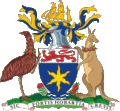History
Europeans settled in the Kingborough Council's district in 1808 at Brown's River (Promenalinah), named after Robert Brown, botanist in 1804. The town and district were both known as Brown's River during the earliest periods of settlement. The Lucas family settled the area and built The Red House, a prominent mansion which is now Kingston Golf Club. Early Kingston developed primarily around The Red House. Development of Kingborough was slow and the first post office opened only in the 1840s. The first road to Hobart, Proctors Road, was opened in 1835. [3]
Kingston was proclaimed a town in 1851. The town's name was suggested by the then Police Magistrate, a member of the Lucas family. By 1890 Kingston had a population of 249. When proclaimed on 20 August 1907, the Kingborough Municipality comprised 3 wards: Kingston, Margate and Longley. On 2 April 1993 Kingborough absorbed the former municipality of Bruny. [2]
In 1877 Keen's Curry was invented in the municipality. [3]
The area developed as a holiday area, especially the suburbs of Kingston Beach and Blackmans Bay. Margate and Kettering operated fishing fleets and Taroona had a manufacturing industry, primarily through Taroona Shot Tower. [3] Sandfly became a centre for small fruits and apple orcharding. [4] The decline of the apple industry progressed during the 1960s, but the industry collapsed entirely following the 1967 Tasmanian fires, when much of the municipality was devastated [5] and most orchards burnt down. [3] A memorial to the 62 fatalities of the fire was constructed in Snug following the fire, where 80 of the towns 120 buildings burned [6] and a permanent exhibition is present at the Channel Heritage Centre.
This page is based on this
Wikipedia article Text is available under the
CC BY-SA 4.0 license; additional terms may apply.
Images, videos and audio are available under their respective licenses.



